DoubleZero Explained: Architecture, Use Cases & 2Z Token
.webp)
Summary: DoubleZero is a crypto project that introduces a new kind of internet infrastructure that connects blockchains through private, high-speed fiber networks instead of relying on the public internet.
It acts as a global transport layer for decentralized systems, improving bandwidth, latency, and reliability so blockchains like Solana can operate at real-world, Nasdaq-level speed and scale.
DoubleZero, the world’s first Network Layer 1 (N1), connects blockchains through high-speed private fiber, delivering low-latency, verifiable global communication.
Active Links
70+ fiber routes in 25 cities
Supported Networks
Solana, Ethereum, L2s, RPCs
Key Features
Multicast, Edge Filtration, 2Z Token
Every day, 99.99% of all internet traffic moves through a few thousand fiber cables controlled by fewer than 20 Tier-1 providers. That means every blockchain, every transaction, and every decentralized system still depends on the same centralized infrastructure built for simple things like emails and web pages over 30 years ago.
No matter how fast Layer 1s or Layer 2s claim to be, they are still bound by that old plumbing of latency, jitter, congestion, and distance. The result is simple: high-performance software running on low-performance roads.
DoubleZero is a new project that seeks to change that by converting underused private fiber into a permissionless, high-speed network layer connecting blockchains, data centers & distributed applications.
Continue reading to find out everything you need to know about DoubleZero. 👇
What is DoubleZero?
DoubleZero is the world’s first Network Layer 1 (N1), a decentralized infrastructure layer that connects and accelerates all Layer 1 and Layer 2 blockchains. Unlike the public internet, it synchronizes global bandwidth to provide low latency, deterministic routing, and verifiable network performance for distributed systems.
Instead of being a blockchain, DoubleZero is a neutral high-speed transport layer that builds a private fast lane between networks. It unites private fiber links from independent contributors into a global mesh network that eliminates jitter, packet loss, and routing inefficiencies.
DoubleZero is the high-performance backbone of the decentralized web, helping validators, protocols, and applications communicate faster and more reliably. By optimizing data flow at the physical layer, it enables blockchains like Ethereum, Solana, and Arbitrum to scale and operate at peak performance.
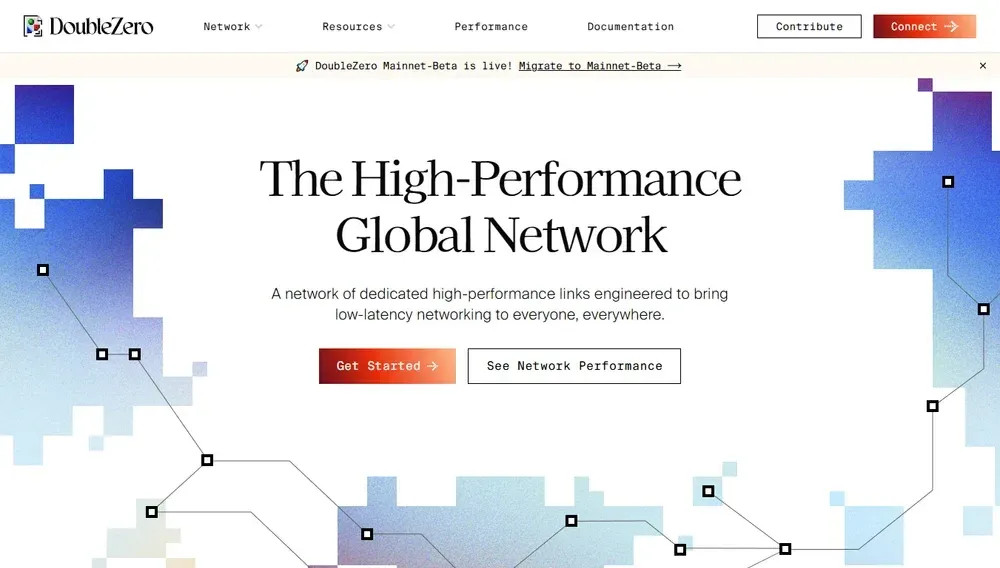
How Does DoubleZero Work?
DoubleZero works by connecting privately contributed fiber links, specialized hardware, and onchain smart contracts into a unified global communication layer.
Its architecture separates data filtration, routing, and consensus flow while using smart contracts to coordinate configurations, verify performance, and manage contributor incentives transparently.
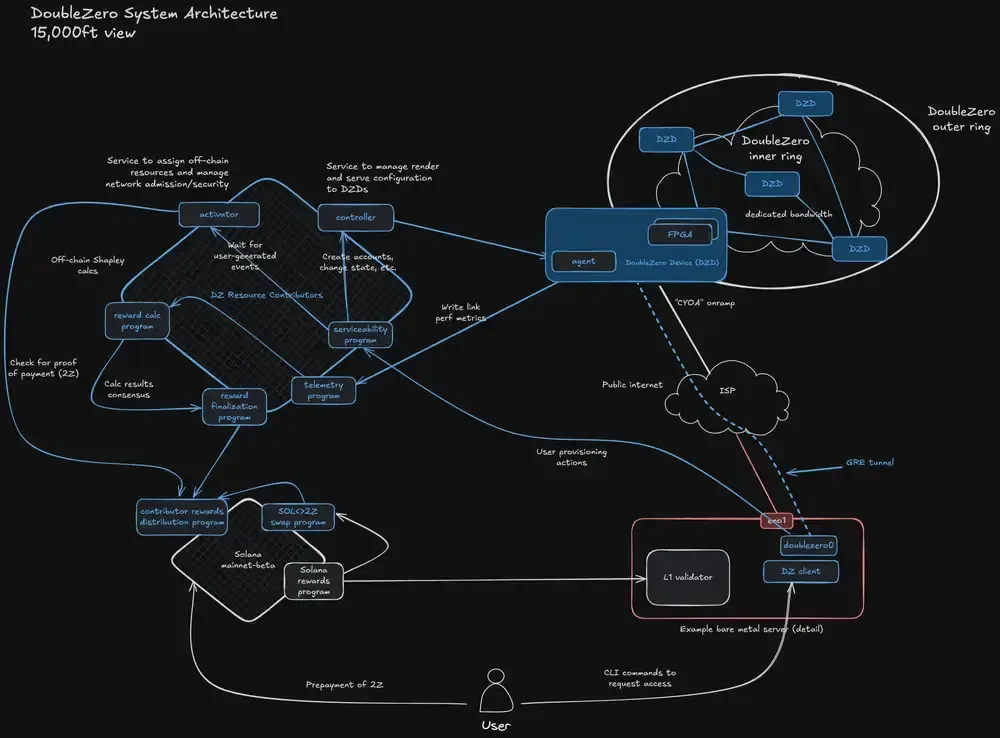
Outer and Inner Rings
The Outer Ring connects DoubleZero to the public internet while filtering spam, verifying packets, and blocking attacks before traffic reaches the network core. Specialized hardware at this layer ensures that only valid and authenticated data enters the system, reducing validator workload and improving network reliability.
The Inner Ring forms the optimized core that links participants through low-latency, dedicated bandwidth connections. Free from public internet congestion, it supports high-speed consensus and synchronized state updates across blockchains and distributed systems.
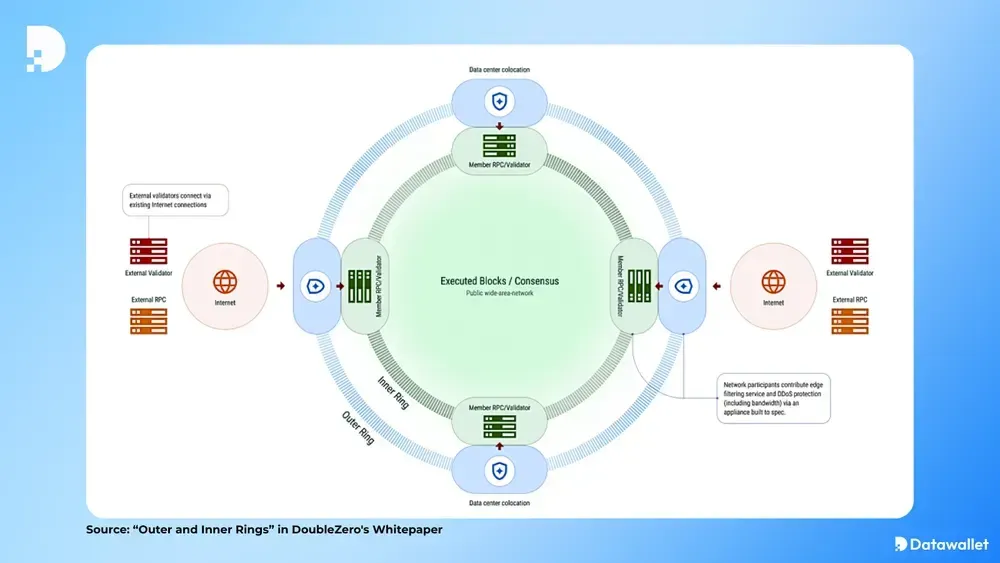
DoubleZero Devices and Hardware
DoubleZero Devices (DZDs) are specialized network enclosures deployed in data centers that terminate fiber links and process network traffic. Each device runs the DoubleZero Agent software, which applies configurations and enforces routing rules based on verified smart contract instructions.
These devices often use Field Programmable Gate Arrays (FPGAs) to perform signature verification and packet deduplication at line speed. Offloading these tasks from validator servers lowers computational overhead, allowing faster transaction propagation and reduced latency across the network.
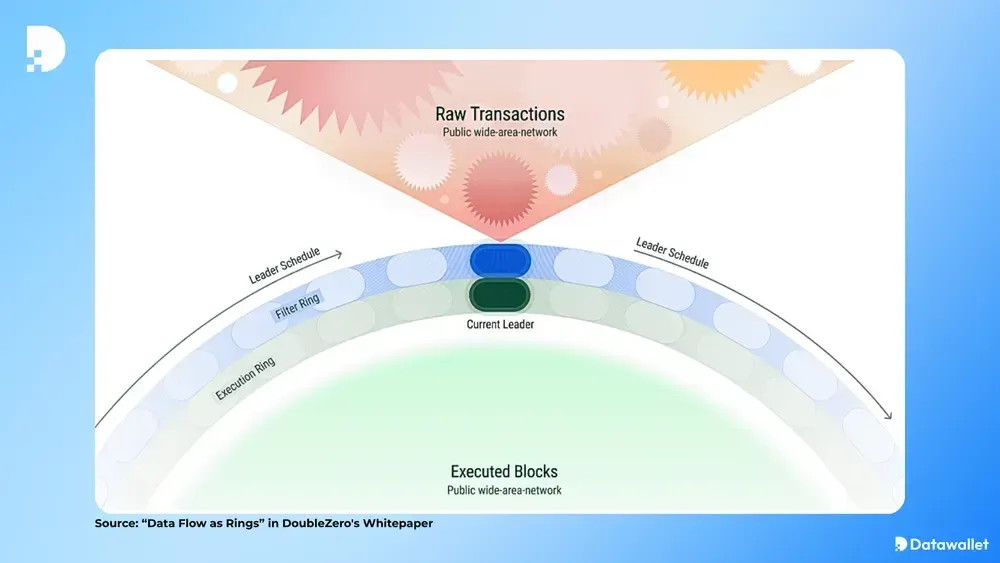
DoubleZero Exchange (DZX)
DoubleZero Exchanges (DZXs) are regional interconnection hubs where independent contributor networks meet and interlink. Located in major metro areas, DZXs merge individual fiber routes into a cohesive, high-performance mesh that spans global data centers.
This structure ensures redundancy and optimized routing, allowing network traffic to move through the most efficient available paths. By connecting multiple contributors in each region, DZXs maintain decentralization while improving throughput and fault tolerance.
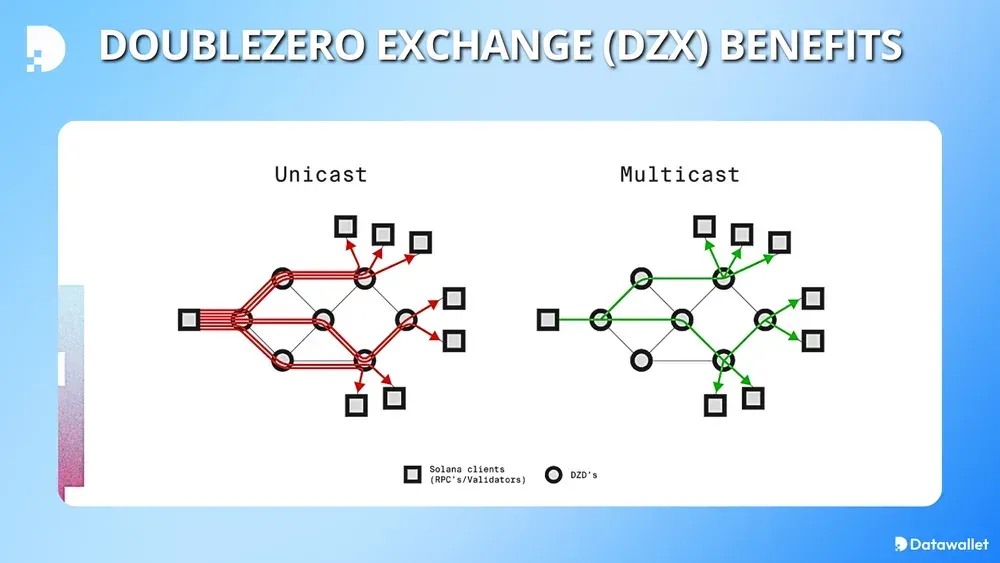
Software Components
The DoubleZero Daemon (doublezerod) manages tunnels, routing tables, and network communication between hosts and devices. The Agent applies updates to device configurations, while the Controller translates onchain smart contract data into real-world routing and performance rules.
The Activator assigns IP ranges and synchronizes network state changes based on blockchain events. Together, these software layers maintain accurate configuration, transparency, and continuous synchronization across all nodes on the DoubleZero network.
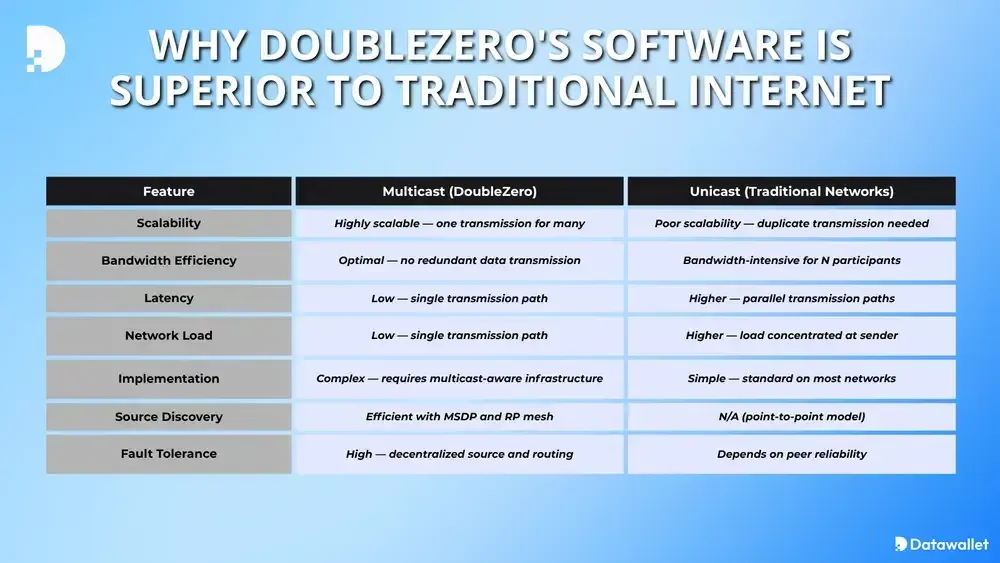
Other Components
Several complementary systems further optimize DoubleZero’s performance, transparency, and scalability across its global mesh network. Each component strengthens the platform’s Proof of Utility model, optimizes routing accuracy, and reinforces economic alignment between users and contributors.
The following are the remaining core elements of DoubleZero:
- Edge Filtration: Removes spam and duplicate traffic before reaching validators to reduce load and improve throughput.
- Multicast Transport: Sends one data stream to multiple recipients simultaneously, conserving bandwidth and accelerating propagation.
- Verifiable Routing: Publishes latency and service metrics onchain, allowing transparent validation of network quality.
- IBRL Mode: Enables seamless fallback to the public internet during temporary DoubleZero outages.
- Contributor Incentives: Rewards providers of compliant, high-quality links and hardware through smart contract–based performance tracking.
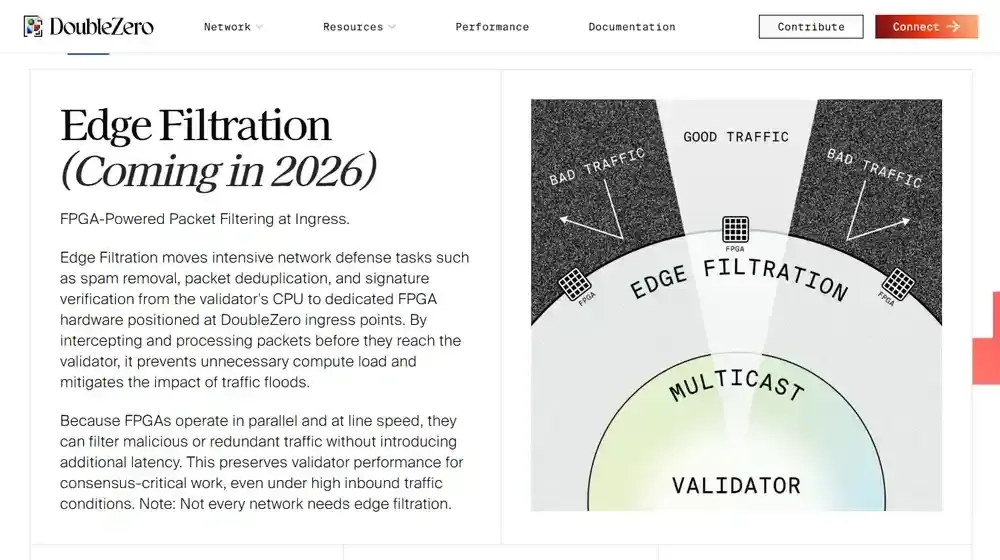
How to Connect to DoubleZero
Connecting to DoubleZero involves preparing your validator environment, generating an identity, verifying ownership, and linking your node through onchain registration. The process ensures authenticated access to the DoubleZero network while maintaining compatibility with your existing blockchain client.
Follow these steps to connect your validator or node:
- Prepare your environment: Install DoubleZero directly on your validator host (not in a container) running Ubuntu, Debian, or RHEL with root access and a public IP.
- Install DoubleZero packages: Use the provided repository links to install or upgrade "doublezerod", then verify the service status with "systemctl status doublezerod".
- Create the configuration directory: Add your Solana validator identity file (for example, "validator-keypair.json") to "~/.config/doublezero/" to link your validator credentials.
- Generate your DoubleZero identity: Run "doublezero keygen" to create a new identity for your server that represents it within the DoubleZero network.
- Retrieve and confirm your identity: Use "doublezero address" to view your DoubleZero ID and ensure it matches the one used during setup and proof creation.
- Prove validator ownership: Sign a message containing your DoubleZero ID with your validator’s Solana identity key to verify control of your node.
- Submit the connection request: Send your identity, signed proof, and configuration details to DoubleZero for validation and network provisioning.
- Test connectivity: Run "doublezero latency" to confirm communication with available DoubleZero Devices and verify that latency results meet expected performance.
- Enable monitoring: Optionally activate Prometheus metrics for real-time visibility into latency, throughput, and overall connection health.
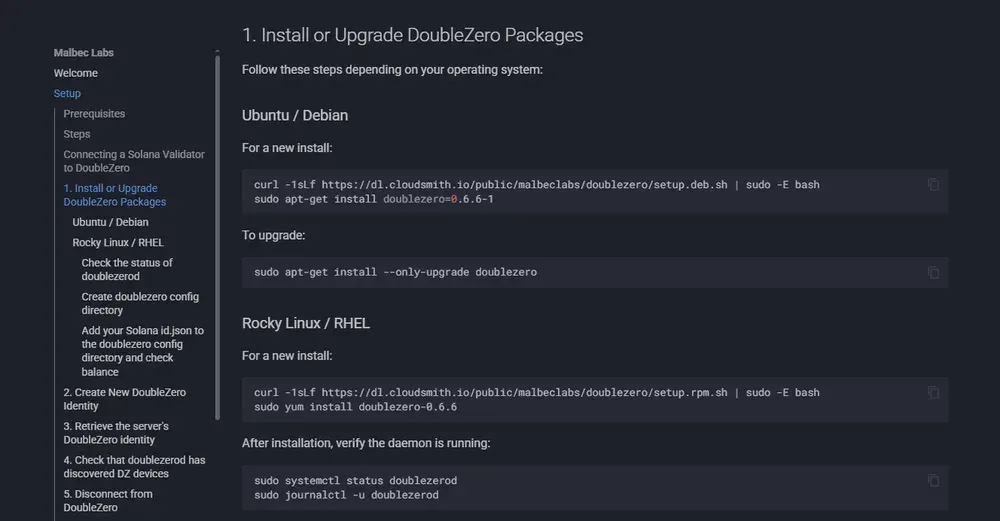
Fees and Requirements
Validators connecting to DoubleZero pay a 5% seat fee on consensus-related revenue. This fee funds network operation, infrastructure scaling, and contributor rewards. Nodes must run on x86_64 Linux servers with public IP connectivity and maintain at least 1 SOL on their validator identity account.
Becoming a network contributor (providing dedicated bandwidth and hardware) requires an estimated capital investment between $60,000 and $130,000, depending on jurisdiction and link configuration. Contributors are compensated in 2Z tokens for maintaining high-quality connectivity and meeting performance benchmarks.
DoubleZero Delegation Program Explained
The DoubleZero Delegation Program is a Solana stake pool seeded with 3,000,000 SOL to improve network reliability, and decentralization. Validators connected to the DoubleZero mainnet-beta network, maintaining under 10% commission, over 10,000 staked SOL, and continuous uptime qualify for regular stake allocations, rebalanced once per week.
Phase 1 focuses on validators already connected to DoubleZero, rewarding early participants helping optimize performance before the full mainnet launch. Phase 2 targets geographic decentralization, prioritizing validators in underserved regions as DoubleZero expands its global fiber network and access points.
A Solana validator linked to DoubleZero with 10,000+ SOL and strong uptime can earn weekly delegations tracked on Solana Explorer (view pool), paying a 6% management fee. Validators can connect through testnet or mainnet-beta, claim dzSOL at Sanctum, swap via Jupiter, and follow updates in the DoubleZero Discord.
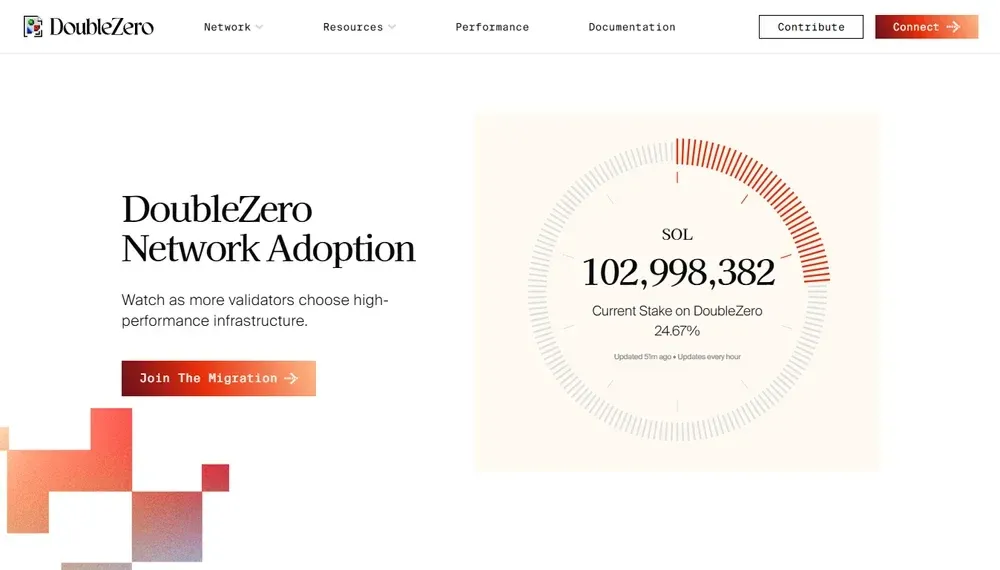
DoubleZero Use Cases
According to its whitepaper, DoubleZero strengthens the performance and reliability of any distributed system where data speed, synchronization, and stability are critical, benefiting more than just blockchains.
Here are the primary use cases for DoubleZero:
- Layer 1 Blockchains: Improves validator communication with low-latency routing, real-time filtration, and multicast propagation to accelerate block production and finality.
- RPC Nodes: Strengthens resilience against DDoS attacks and ensures faster, more reliable transaction delivery and state updates to users and dApps.
- MEV Systems: Increases competitiveness by minimizing latency between searchers and validators, enabling faster bundle delivery and improved block efficiency.
- Layer 2 Blockchains: Boosts sequencer coordination, data availability syncing, and inter-chain messaging to reduce congestion and improve state verification.
- Indexers and State Sync: Enables faster synchronization for new validators, indexers, and catch-up nodes through high-bandwidth, low-latency data streaming.
- Content Delivery Networks: Provides flexible, on-demand private bandwidth that reduces load times, improves routing, and removes dependency on long-term infrastructure leases.
- Online Gaming: Reduces lag and jitter for real-time multiplayer experiences, ensuring smoother gameplay regardless of geographic distance or network load.
- Large Language Model Training: Accelerates distributed AI training by connecting GPU clusters across multiple data centers with high-bandwidth, deterministic networking.
- Enterprise Networking: Offers elastic, permissionless private bandwidth to meet dynamic traffic demands without the rigidity or cost of traditional leased-line contracts.
DoubleZero $2Z Tokenomics
The 2Z token is the native SPL asset of DoubleZero, powering payments, staking, and contributor rewards across the global network. With a total launch supply of 10 billion tokens, 2Z maintains a dynamic balance through inflation-based issuance and periodic token burns to preserve fairness and network integrity.
Here’s the allocation and utility breakdown for 2Z:
- DoubleZero Foundation & Ecosystem: 29% allocated to governance, ecosystem development, and long-term sustainability, fully unlocked at launch for operational use.
- Jump Crypto: 28% allocation with 5% unlocked at launch; the rest follows the standard vesting lockup schedule to align long-term incentives.
- Malbec Labs: 14% reserved for protocol development and maintenance, subject to the standard lockup to ensure steady contribution to the ecosystem.
- Team: 10% allocated to founding and core contributors, vested under the standard lockup to maintain alignment with project growth.
- Institutions: 12% dedicated to strategic partners supporting infrastructure, liquidity, and ecosystem adoption, subject to the standard lockup.
- Contributors: 4% designated for independent network operators providing bandwidth and hardware capacity under verifiable service-level agreements.
- Builders: 2% committed to developers building on or integrating with the DoubleZero network stack, locked under the standard schedule.
- Validators: 1% set aside for validators; 0.7% unlocked at launch and the rest releasing after one year from purchase.
The 2Z token launched with DoubleZero’s mainnet-beta in October 2025 after receiving an SEC No-Action Letter confirming compliance. Soon after listing, 2Z fell over 40% due to token unlocks, insider allocations, and unclear circulating supply data, even though the founders confirmed no tokens were sold by the team.
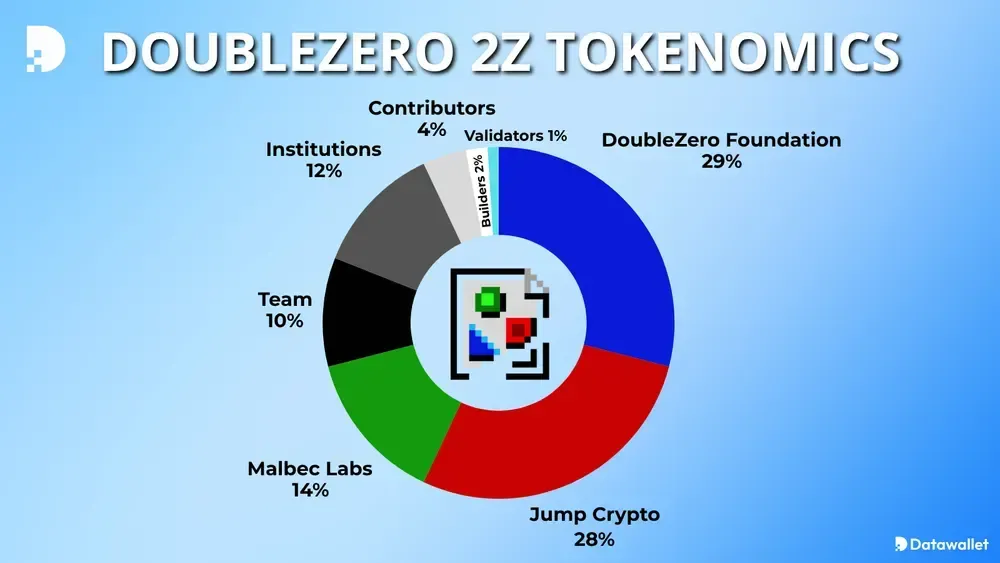
DoubleZero Statistics
DoubleZero currently supports over 24.6% of Solana’s total mainnet stake weight, with 21 active global locations participating in validator operations. The network consistently achieves 99.997% earned credit rate, outperforming the public internet’s 99.972%, reflecting its reliability and stability for distributed systems.
Average vote latency remains at 1.005 slots, matching optimal Solana timing while reducing missed credits by more than 8x compared to public internet routes. These metrics confirm DoubleZero’s productivity as a dedicated transport layer, significantly improving validator coordination and consensus speed.
Top-performing validators include Figment, Galaxy, Everstake, RockawayX, and Staking Facilities, representing major global hubs across Frankfurt, London, New York, Amsterdam, and Prague. Together, they demonstrate the network’s expanding geographic footprint and its role in strengthening Solana’s infrastructure

DoubleZero Founders
DoubleZero was founded by Austin Federa, Andrew McConnell, and Mateo Ward. Austin Federa, formerly Head of Strategy at the Solana Foundation and an early leader at Bison Trails, guides the project’s overall strategic direction and is the public face of the company in most podcasts and media appearances.
Andrew McConnell and Mateo Ward bring deep technical and networking expertise. Andrew serves as CTO, specializing in infrastructure engineering and protocol design, while Mateo focuses on fiber optics, low-latency systems, and the project’s physical network architecture.
The DoubleZero Foundation oversees governance, decentralization, and adoption while coordinating contributions from Malbec Labs, Jump Crypto, Anza, and Galaxy. These independent partners provide engineering expertise, infrastructure development, and long-term support for the network’s global growth.
The founders share a vision of building a permissionless, high-speed transport layer for decentralized systems worldwide. Their mission is to extend decentralization into the physical internet layer, enabling faster, more secure, and censorship-resistant connectivity.
Risks and Concerns of DoubleZero
While DoubleZero introduces a groundbreaking model for decentralized networking, it also carries notable risks related to hardware, blockchain technology, economics, and governance. Understanding these challenges is essential for validators, contributors, and investors participating in the ecosystem.
Key risks and concerns include:
- Hardware and Fiber Dependence: The network’s performance relies on privately contributed fiber links and specialized hardware, which may face outages, degradation, or supply constraints.
- Geopolitical Exposure: Physical routes across multiple jurisdictions introduce risks from regional regulations, cross-border data policies, or potential disruptions to undersea cables.
- Smart Contract Reliability: DoubleZero’s coordination and incentive mechanisms depend on smart contracts, which could contain bugs, exploits, or logic flaws affecting operations.
- Token Distribution Imbalance: Large initial allocations to insiders and partners may limit decentralization and influence governance decisions disproportionately.
- Regulatory Ambiguity: Even with an SEC No-Action Letter, global interpretations of DePIN rewards remain uncertain and could shift with new policy frameworks.
- Economic Viability: Sustaining contributor rewards and infrastructure incentives depends on token demand and network traffic growth, which may fluctuate during early adoption.
- Operational Complexity: Maintaining high-performance nodes and fiber routes across continents requires costly coordination and ongoing technical expertise from contributors.
- Transparency and Data Integrity: Unclear reporting of circulating supply, vesting schedules, and performance metrics could erode community trust if not consistently audited.
Final Thoughts
DoubleZero already operates more than 70 high-capacity fiber routes across 25 cities, carrying roughly one-fourth of Solana’s mainnet stake weight through its dedicated network.
Austin Federa described this as “the missing hardware layer,” one capable of pushing decentralized systems toward Nasdaq-level throughput, reaching tens of thousands of transactions per second without sacrificing global accessibility or decentralization.
With deterministic routing, multicast transport, and plans to reach 100 gigabit multi-path performance, DoubleZero is no longer a whitepaper but the first real attempt to make blockchains operate at the speed of modern markets.
Frequently asked questions
Is DoubleZero compatible with existing blockchain clients and validator software?
Yes. DoubleZero integrates with existing validator and RPC clients without code changes, providing an optional high-speed network layer for faster data transport.
How is DoubleZero funded?
DoubleZero secured $28 million in a token round co-led by Multicoin Capital and Dragonfly Capital to accelerate its fiber deployment and infrastructure scaling. During that sale, more than 1,600 validators applied but only 260 passed KYC and allocation thresholds.
Can DoubleZero be used for non-blockchain applications?
Absolutely. The network’s low-latency fiber infrastructure also benefits content delivery, online gaming, enterprise networking, and large AI model training and inference.
When will DoubleZero’s software stack be open-sourced?
The full DoubleZero software stack is expected to be open-sourced in late 2025, following completion of audits and security reviews.
How does DoubleZero prevent network abuse or spam traffic?
DoubleZero uses edge filtration and verifiable routing, removing spam and duplicate packets before they reach validators while maintaining transparent on-chain performance logs.
.webp)
Written by
Jed Barker
Editor-in-Chief
Jed, a digital asset analyst since 2015, founded Datawallet to simplify crypto and decentralized finance. His background includes research roles in leading publications and a venture firm, reflecting his commitment to making complex financial concepts accessible.


%25201%2520(1).webp)
.webp)
%20in%20Taiwan.webp)
%2520(1).webp)




